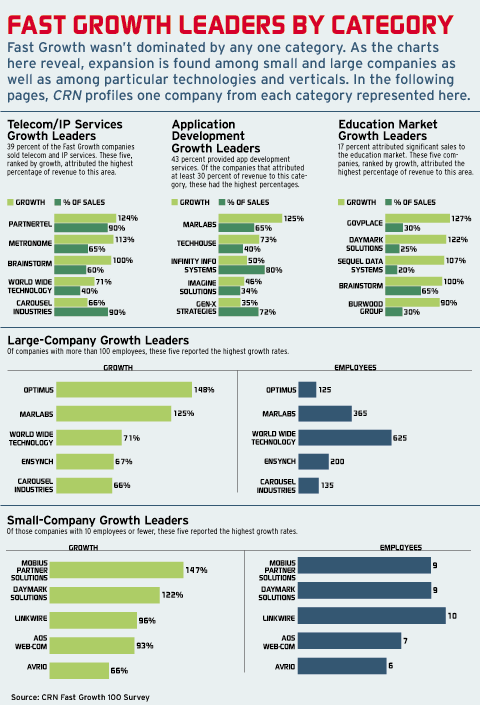Hitting The Mark

\
Achieving growth in an economy still under pressure is no easy task. But the Fast Growth 100 solution providers demonstrate that success can be achieved even under difficult conditions—and it can emerge from a diversity of business models.
The Fast Growth 100 List, based on a survey and call for nominations conducted by CRN during the fourth quarter and ranked by revenue growth over the 12 months ended June 30, 2004, represents every conceivable variation on the solution provider theme.
The range starts with Maverick Computers, the fastest-growing solution provider in the survey, which not coincidentally was also recognized by CRN earlier this year as the fastest-growing custom-system builder. Maverick, West Palm Beach, Fla., relied on contract manufacturers as it became increasingly focused on its custom-system business.

Pumping up product sales was by no means the only way solution providers achieved above-average growth. Among the top performers are solution providers that are developing custom applications, focusing on vertical market solutions, driving growth through managed services and building expertise in security and other technology areas.
Though a mixed bag, there was one common theme that helped many of these solution providers excel: They targeted niches or became increasingly specialized.
| AD | |
|---|---|
| id | unit-1659132512259 |
| type | Sponsored post |
Net@Work, which grew 31 percent over the period, honed its focus on the growing hedge fund market. Edward Solomon, co-founder and co-president of Net@Work, said the New York-based solution provider dedicated a sales force to the vertical market to ensure that they understood their customers’ business needs at a deep level.
The team’s expertise in the field and tight customer relationships generated incremental business and in one instance almost tripled the size of the contract, Solomon said. “We were originally brought in to set up the IT room, put hardware and software on the desks,” he said. “That was expanded into disaster recovery, moving a data center and [providing] faxing and office equipment. We are still working on a document-imaging project.”
Outsourcing through partnerships was another common theme among many solution providers on our inaugural list. When CEO John Marks, a former CDW executive, started JDM Infrastructure, Rosemont, Ill., in 2000, he stuck with his core competency of hardware sales and turned to partners to provide services, a strategy that helped his business grow 200 percent to $36 million. “I saw that many companies had underutilized technicians, and I could take advantage of that,” Marks said.
Then there is Sean Murphy, co-founder of Canvas Systems, Norcross, Ga., who turned his experience in the leasing business into a thriving used-equipment business. The products can be paired with maintenance contracts and placed in mission-critical environments, rented out for short leases or even sold overseas, where pricing pressures are more intense. Margins average between 15 percent and 20 percent, Murphy said.
“With the downturn in the tech industry, we acquired a new caliber of customers,” he said. “Their budgets forced them to look at preowned equipment. Now they are happy they did.”
Product sales contributed to growing revenue for most of the solution providers. But several companies demonstrated how to build a profitable company based on services. FusionStorm, No. 3 on the list, began its transition to the MSP model in early 2001. The model has clearly paid off: FusionStorm realized a 261 percent increase in revenue during the survey period.
John Varel, chairman and CEO of the San Francisco-based company, said while it took time to build up the business, customers are now turning to FusionStorm to outsource other aspects of their operations, such as application development.
Telecom services provider Partnertel, Atlanta, also has seen rapid growth from its managed services business. As margins began to erode in the telecom space, Partnertel executives developed a managed service to help customers monitor telecom inventory and billing. Partnertel CEO Steven Gareleck said the service can save customers a minimum of 20 percent of yearly telecom spending.
By placing the emphasis on revenue growth rather than size, the Fast Growth 100 List is meant to reflect the channel in all its diversity and turn the spotlight on some of those business models that are enjoying success in the current economy.
Small companies clearly have an advantage when it comes to growing fast, and the list includes five companies with less than $1 million in sales, most notably DataTech Enterprises, Fredericksburg, Va., which grew its sales 273 percent to $1 million. To qualify for the list, each company had to be an independently owned business since at least 2001 and have sales of at least $250,000.
But participants in the survey also represented many larger companies. The average participant reported $55 million in sales and grew 37 percent. Several large companies beat that average, including World Wide Technology, St. Louis, which reported $1.37 billion in sales and grew 71 percent over the period.
In the following pages, we profile 10 of the Fast Growth 100 solution providers. We not only looked at the top five leaders on the list, but also at companies that turned in above-average performances in some key subcategories.
We chose World Wide Technology as an example of a large company—with 625 employees—that still managed impressive growth, and Partnertel, a company that derives 90 percent of its revenue from telecom services but developed the innovative managed service noted above to spur growth.
Brainstorm Networks, Denver, is one of several companies that told us that education was an important vertical market. The solution provider, which has expanded into the VoIP space, gets about 65 percent of its revenue from the education market.
Daymark Solutions, in North Billerica, Mass., was a fitting example of a company with just a few employees that still managed impressive growth. And Edison, N.J.-based Marlabs made the cut by demonstrating excellence in its specialty: application development.
We discovered that these five companies showed up on several of the top-five charts presented below. For example, Marlabs placed in the top five among application developers, as well as companies with more than 100 employees. And Brainstorm Networks appeared on the top-five chart of companies specializing in telecom/IP, as well as those specializing in the education vertical.
Solution providers on the top-100 list are as varied as the companies they service, but they all have one thing in common: fast growth.
